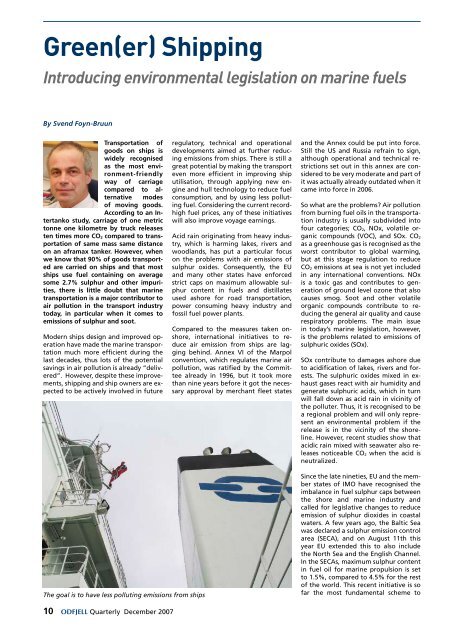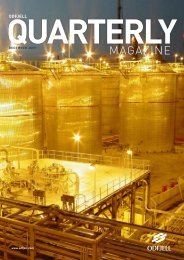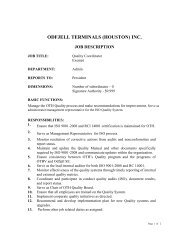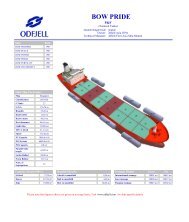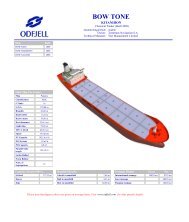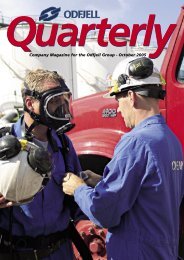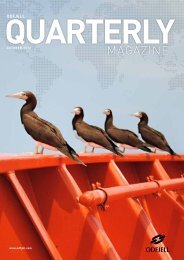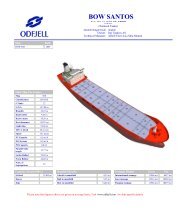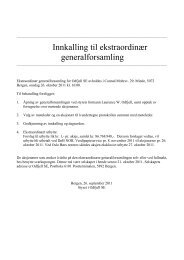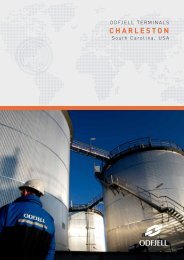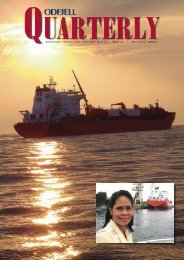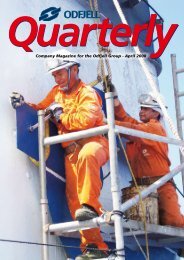Create successful ePaper yourself
Turn your PDF publications into a flip-book with our unique Google optimized e-Paper software.
Green(er) ShippingIntroducing environmental legislation on marine fuelsBy Svend Foyn-BruunTransportation ofgoods on ships iswidely recognisedas the most environment-friendlyway of carriagecompared to alternativemodesof moving goods.According to an Intertankostudy, carriage of one metrictonne one kilometre by truck releasesten times more CO 2 compared to transportationof same mass same distanceon an aframax tanker. However, whenwe know that 90% of goods transportedare carried on ships and that mostships use fuel containing on averagesome 2.7% sulphur and other impurities,there is little doubt that marinetransportation is a major contributor toair pollution in the transport industrytoday, in particular when it comes toemissions of sulphur and soot.Modern ships design and improved operationhave made the marine transportationmuch more efficient during thelast decades, thus lots of the potentialsavings in air pollution is already “delivered”.However, despite these improvements,shipping and ship owners are expectedto be actively involved in futureregulatory, technical and operationaldevelopments aimed at further reducingemissions from ships. There is still agreat potential by making the transporteven more efficient in improving shiputilisation, through applying new engineand hull technology to reduce fuelconsumption, and by using less pollutingfuel. Considering the current recordhighfuel prices, any of these initiativeswill also improve voyage earnings.Acid rain originating from heavy industry,which is harming lakes, rivers andwoodlands, has put a particular focuson the problems with air emissions ofsulphur oxides. Consequently, the EUand many other states have enforcedstrict caps on maximum allowable sulphurcontent in fuels and distillatesused ashore for road transportation,power consuming heavy industry andfossil fuel power plants.Compared to the measures taken onshore,international initiatives to reduceair emission from ships are laggingbehind. Annex VI of the Marpolconvention, which regulates marine airpollution, was ratified by the Committeealready in 1996, but it took morethan nine years before it got the necessaryapproval by merchant fleet statesand the Annex could be put into force.Still the US and Russia refrain to sign,although operational and technical restrictionsset out in this annex are consideredto be very moderate and part ofit was actually already outdated when itcame into force in 2006.So what are the problems? Air pollutionfrom burning fuel oils in the transportationindustry is usually subdivided intofour categories; CO 2, NOx, volatile organiccompounds (VOC), and SOx. CO 2as a greenhouse gas is recognised as theworst contributor to global warming,but at this stage regulation to reduceCO 2 emissions at sea is not yet includedin any international conventions. NOxis a toxic gas and contributes to generationof ground level ozone that alsocauses smog. Soot and other volatileorganic compounds contribute to reducingthe general air quality and causerespiratory problems. The main issuein today’s marine legislation, however,is the problems related to emissions ofsulphuric oxides (SOx).SOx contribute to damages ashore dueto acidification of lakes, rivers and forests.The sulphuric oxides mixed in exhaustgases react with air humidity andgenerate sulphuric acids, which in turnwill fall down as acid rain in vicinity ofthe polluter. Thus, it is recognised to bea regional problem and will only representan environmental problem if therelease is in the vicinity of the shoreline.However, recent studies show thatacidic rain mixed with seawater also releasesnoticeable CO 2 when the acid isneutralized.The goal is to have less polluting emissions from shipsSince the late nineties, EU and the memberstates of IMO have recognised theimbalance in fuel sulphur caps betweenthe shore and marine industry andcalled for legislative changes to reduceemission of sulphur dioxides in coastalwaters. A few years ago, the Baltic Seawas declared a sulphur emission controlarea (SECA), and on August 11th thisyear EU extended this to also includethe North Sea and the English Channel.In the SECAs, maximum sulphur contentin fuel oil for marine propulsion is setto 1.5%, compared to 4.5% for the restof the world. This recent initiative is sofar the most fundamental scheme to10 <strong>Odfjell</strong> <strong>Quarterly</strong> <strong>December</strong> <strong>2007</strong>


